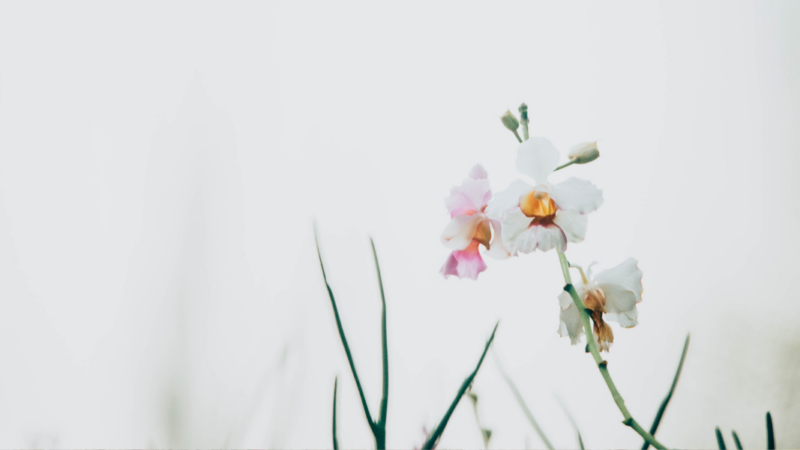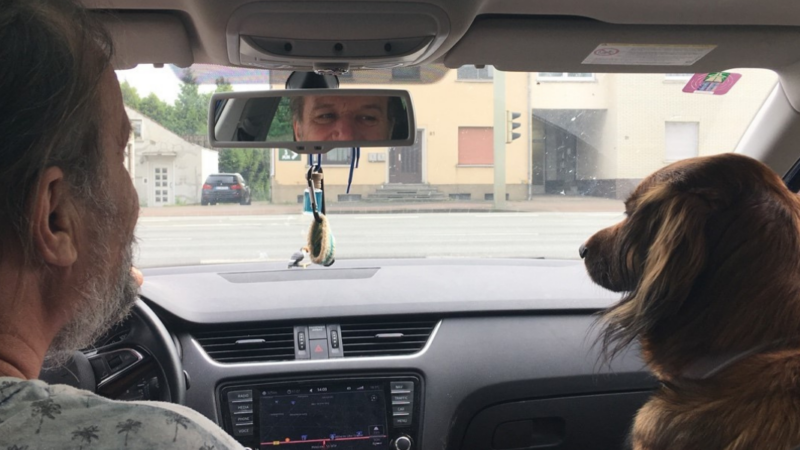The Courage to Stand Alone
The Courage to Stand Alone
It can be scary when we are called to confront our aloneness, the seemingly infinite depths of that empty, homeless feeling inside of us. When all our old protections fall away and the abandoned and neglected ones inside come begging for our love and attention. It can feel sometimes as though there’s nowhere to turn, like we want to crawl out of our own skin, urgently get out of the Now and into some other time or place.
It takes bravery to stop, breathe, and—slowly, slowly, slowly—turn back toward the lonely, dark, empty “void” inside (in reality, there is no void). To actually turn to face the sense of abandonment buried deep within our guts, to soften into the sense of separation that has been with us for as long as we can remember. We don’t have to make the feeling go away today, only lean into it, breathe into it, begin to make room for it, maybe even learn to trust its presence.
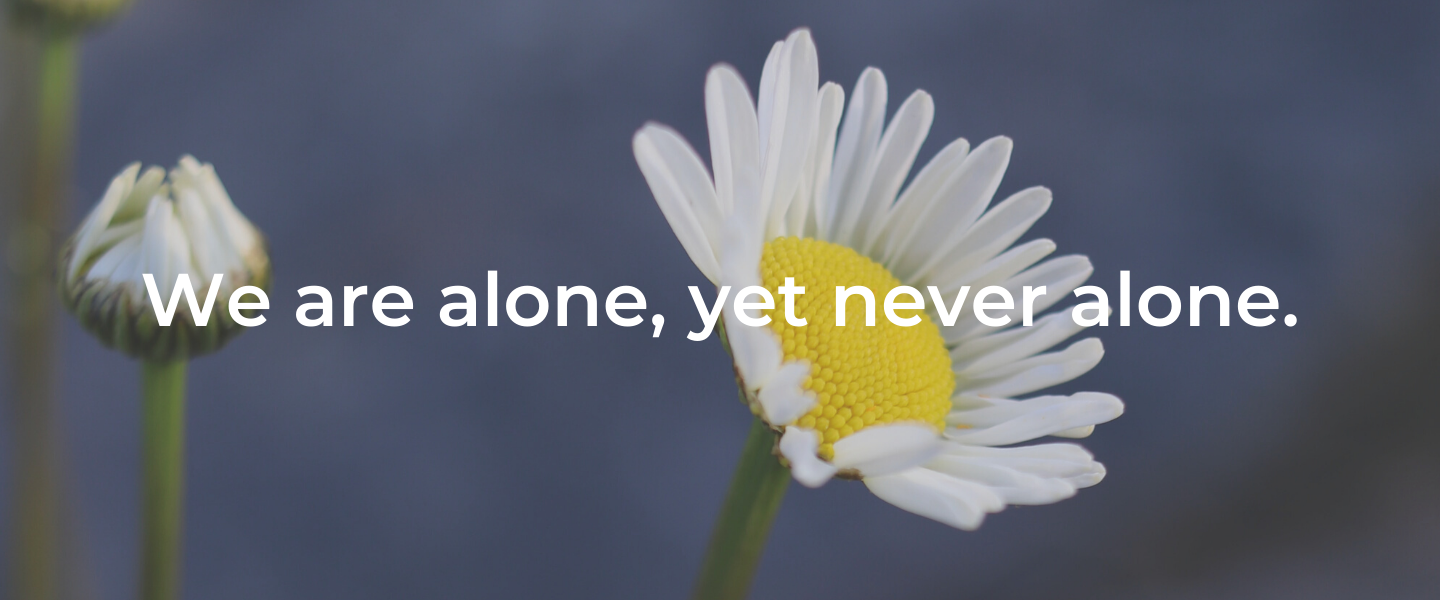
Perhaps loneliness is like a cosmic nostalgia, a preverbal memory of a deep womb-connection, with ourselves, with the planet, with every being who has ever lived. In leaning into our own loneliness, shame, and existential anxiety, we may be able to touch into compassion for the loneliness of every human being, for every heart longing to connect, for every grieving heart, every frightened heart.
We are alone, yet never alone. This is the great paradox of existence. Our loneliness, when not resisted or numbed away, may actually end up connecting us more deeply to life and each other, like it did for me and my sweet father that winter evening.
Let us learn to be alone, then! Alone, without distraction, which is true meditation. Alone, communing with the breath as it rises and falls. Alone with the mind and its incredible dance. Alone with the rain and the morning sun. Alone with the crackle of autumn leaves under our feet, or the crunch of winter snow. Alone with the hopes and joys and anxieties of this human form, living a single day on this remarkable planet. Alone with our precious selves, with this unfathomable sense of connection to all things, with birth and loss and death and their myriad mysteries.
Alone, with all of life.
This is an excerpt from You Were Never Broken: Poems to Save Your Life by Jeff Foster.
 Jeff Foster shares from his own awakened experience a way out of seeking fulfillment in the future and into the acceptance of “all this, here and now.” He studied astrophysics at Cambridge University. Following a period of depression and physical illness, he embarked on an intensive spiritual search that came to an end with the discovery that life itself was what he had always been seeking.
Jeff Foster shares from his own awakened experience a way out of seeking fulfillment in the future and into the acceptance of “all this, here and now.” He studied astrophysics at Cambridge University. Following a period of depression and physical illness, he embarked on an intensive spiritual search that came to an end with the discovery that life itself was what he had always been seeking.
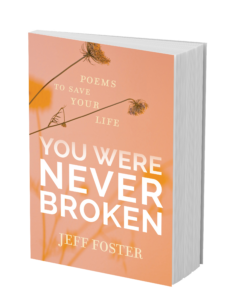
Learn More
Waking Up to Your World, by Pema Chödrön
Enjoy this inspiring article and vision from our dear friend Pema Chödrön, courtesy of our friends at Shambhala Sun. Here, Pema points to the alive nature of the sacred world, which can be found in the midst of the everyday, unfolding out of the center of your very own heart.
Throughout our day we can pause, take a break from our usual thoughts, and wake up to the magic and vastness of the world around us. Pema Chödrön says this easy and spacious type of mindfulness practice is the most important thing we can do with our lives.
Waking Up to Your World, by Pema Chödrön
One of my favorite subjects of contemplation is this question: “Since death is certain, but the time of death is uncertain, what is the most important thing?” You know you will die, but you really don’t know how long you have to wake up from the cocoon of your habitual patterns. You don’t know how much time you have left to fulfill the potential of your precious human birth. Given this, what is the most important thing?
Every day of your life, every morning of your life, you could ask yourself, “As I go into this day, what is the most important thing? What is the best use of this day?” At my age, it’s kind of scary when I go to bed at night and I look back at the day, and it seems like it passed in the snap of a finger. That was a whole day? What did I do with it? Did I move any closer to being more compassionate, loving, and caring—to being fully awake? Is my mind more open? What did I actually do? I feel how little time there is and how important it is how we spend our time.
What is the best use of each day of our lives? In one very short day, each of us could become more sane, more compassionate, more tender, more in touch with the dream-like quality of reality. Or we could bury all these qualities more deeply and get more in touch with solid mind, retreating more into our own cocoon.
Every time a habitual pattern gets strong, every time we feel caught up or on automatic pilot, we could see it as an opportunity to burn up negative karma. Rather than as a problem, we could see it as our karma ripening, which gives us an opportunity to burn up karma, or at least weaken our karmic propensities. But that’s hard to do. When we realize that we are hooked, that we’re on automatic pilot, what do we do next? That is a central question for the practitioner.
One of the most effective means for working with that moment when we see the gathering storm of our habitual tendencies is the practice of pausing, or creating a gap. We can stop and take three conscious breaths, and the world has a chance to open up to us in that gap. We can allow space into our state of mind.
Before I talk more about consciously pausing or creating a gap, it might be helpful to appreciate the gap that already exists in our environment. Awakened mind exists in our surroundings—in the air and the wind, in the sea, in the land, in the animals—but how often are we actually touching in with it? Are we poking our heads out of our cocoons long enough to actually taste it, experience it, let it shift something in us, let it penetrate our conventional way of looking at things?
If you take some time to formally practice meditation, perhaps in the early morning, there is a lot of silence and space. Meditation practice itself is a way to create gaps. Every time you realize you are thinking and you let your thoughts go, you are creating a gap. Every time the breath goes out, you are creating a gap. You may not always experience it that way, but the basic meditation instruction is designed to be full of gaps. If you don’t fill up your practice time with your discursive mind, with your worrying and obsessing and all that kind of thing, you have time to experience the blessing of your surroundings. You can just sit there quietly. Then maybe silence will dawn on you, and the sacredness of the space will penetrate.
Or maybe not. Maybe you are already caught up in the work you have to do that day, the projects you haven’t finished from the day before. Maybe you worry about something that has to be done, or hasn’t been done, or a letter that you just received. Maybe you are caught up in busy mind, caught up in hesitation or fear, depression or discouragement. In other words, you’ve gone into your cocoon.
For all of us, the experience of our entanglement differs from day to day. Nevertheless, if you connect with the blessings of your surroundings—the stillness, the magic, and the power—maybe that feeling can stay with you and you can go into your day with it. Whatever it is you are doing, the magic, the sacredness, the expansiveness, the stillness, stays with you. When you are in touch with that larger environment, it can cut through your cocoon mentality.
On the other hand, I know from personal experience how strong the habitual mind is. The discursive mind, the busy, worried, caught-up, spaced-out mind, is powerful. That’s all the more reason to do the most important thing—to realize what a strong opportunity every day is, and how easy it is to waste it. If you don’t allow your mind to open and to connect with where you are, with the immediacy of your experience, you could easily become completely submerged. You could be completely caught up and distracted by the details of your life, from the moment you get up in the morning until you fall asleep at night.
You get so caught up in the content of your life, the minutiae that make up a day, so self-absorbed in the big project you have to do, that the blessings, the magic, the stillness, and the vastness escape you. You never emerge from your cocoon, except for when there’s a noise that’s so loud you can’t help but notice it, or something shocks you, or captures your eye. Then for a moment you stick your head out and realize, Wow! Look at that sky! Look at that squirrel! Look at that person!
The great fourteenth-century Tibetan teacher Longchenpa talked about our useless and meaningless focus on the details, getting so caught up we don’t see what is in front of our nose. He said that this useless focus extends moment by moment into a continuum, and days, months, and even whole lives go by. Do you spend your whole time just thinking about things, distracting yourself with your own mind, completely lost in thought? I know this habit so well myself. It is the human predicament. It is what the Buddha recognized and what all the living teachers since then have recognized. This is what we are up against.
“Yes, but…,” we say. Yes, but I have a job to do, there is a deadline, there is an endless amount of e-mail I have to deal with, I have cooking and cleaning and errands. How are we supposed to juggle all that we have to do in a day, in a week, in a month, without missing our precious opportunity to experience who we really are? Not only do we have a precious human life, but that precious human life is made up of precious human days, and those precious human days are made up of precious human moments. How we spend them is really important. Yes, we do have jobs to do; we don’t just sit around meditating all day, even at a retreat center. We have the real nitty-gritty of relationships—how we live together, how we rub up against each other. Going off by ourselves, getting away from the people we think are distracting us, won’t solve everything. Part of our karma, part of our dilemma, is learning to work with the feelings that relationships bring up. They provide opportunities to do the most important thing too.
If you have spent the morning lost in thought worrying about what you have to do in the afternoon, already working on it in every little gap you can find, you have wasted a lot of opportunities, and it’s not even lunchtime yet. But if the morning has been characterized by at least some spaciousness, some openness in your mind and heart, some gap in your usual way of getting caught up, sooner or later that is going to start to permeate the rest of your day.
If you haven’t become accustomed to the experience of openness, if you haven’t got any taste of it, then there is no way the afternoon is going to be influenced by it. On the other hand, if you’ve given openness a chance, it doesn’t matter whether you are meditating, working at the computer, or fixing a meal, the magic will be there for you, permeating your life.
As I said, our habits are strong, so a certain discipline is required to step outside our cocoon and receive the magic of our surroundings. The pause practice—the practice of taking three conscious breaths at any moment when we notice that we are stuck—is a simple but powerful practice that each of us can do at any given moment.
Pause practice can transform each day of your life. It creates an open doorway to the sacredness of the place in which you find yourself. The vastness, stillness, and magic of the place will dawn upon you, if you let your mind relax and drop for just a few breaths the storyline you are working so hard to maintain. If you pause just long enough, you can reconnect with exactly where you are, with the immediacy of your experience.
When you are waking up in the morning and you aren’t even out of bed yet, even if you are running late, you could just look out and drop the storyline and take three conscious breaths. Just be where you are! When you are washing up, or making your coffee or tea, or brushing your teeth, just create a gap in your discursive mind. Take three conscious breaths. Just pause. Let it be a contrast to being all caught up. Let it be like popping a bubble. Let it be just a moment in time, and then go on.
You are on your way to whatever you need to do for the day. Maybe you are in your car, or on the bus, or standing in line. But you can still create that gap by taking three conscious breaths and being right there with the immediacy of your experience, right there with whatever you are seeing, with whatever you are doing, with whatever you are feeling.
Another powerful way to do pause practice is simply to listen for a moment. Instead of sight being the predominant sense perception, let sound, hearing, be the predominant sense perception. It’s a very powerful way to cut through our conventional way of looking at the world. In any moment, you can just stop and listen intently. It doesn’t matter what particular sound you hear; you simply create a gap by listening intently.
In any moment you could just listen. In any moment, you could put your full attention on the immediacy of your experience. You could look at your hand resting on your leg, or feel your bottom sitting on the cushion or on the chair. You could just be here. Instead of being not here, instead of being absorbed in thinking, planning, and worrying, instead of being caught up in the cocoon, cut off from your sense perceptions, cut off from the power and magic of the moment, you could be here. When you go out for a walk, pause frequently—stop and listen. Stop and take three conscious breaths. How precisely you create the gap doesn’t really matter. Just find a way to punctuate your life with these thought-free moments. They don’t have to be thought-free minutes even, they can be no more than one breath, one second. Punctuate, create gaps. As soon as you do, you realize how big the sky is, how big your mind is.
When you are working, it’s so easy to become consumed, particularly by computers. They have a way of hypnotizing you, but you could have a timer on your computer that reminds you to create a gap. No matter how engrossing your work is, no matter how much it is sweeping you up, just keep pausing, keep allowing for a gap. When you get hooked by your habit patterns, don’t see it as a big problem; allow for a gap.
When you are completely wound up about something and you pause, your natural intelligence clicks in and you have a sense of the right thing to do. This is part of the magic: our own natural intelligence is always there to inform us, as long as we allow a gap. As long as we are on automatic pilot, dictated to by our minds and our emotions, there is no intelligence. It is a rat race. Whether we are at a retreat center or on Wall Street, it becomes the busiest, most entangled place in the world.
Pause, connect with the immediacy of your experience, connect with the blessings; liberate yourself from the cocoon of self-involvement, talking to yourself all of the time, completely obsessing. Allow a gap, gap, gap. Just do it over and over and over; allow yourself the space to realize where you are. Realize how big your mind is; realize how big the space is, that it has never gone away, but that you have been ignoring it.
Find a way to slow down. Find a way to relax. Find a way to relax your mind and do it often, very, very often, throughout the day continuously, not just when you are hooked but all the time. At its root, being caught up in discursive thought, continually self-involved with discursive plans, worries, and so forth, is attachment to ourselves. It is the surface manifestation of ego-clinging.
So, what is the most important thing to do with each day? With each morning, each afternoon, each evening? It is to leave a gap. It doesn’t matter whether you are practicing meditation or working, there is an underlying continuity. These gaps, these punctuations, are like poking holes in the clouds, poking holes in the cocoon. And these gaps can extend so that they can permeate your entire life, so that the continuity is no longer the continuity of discursive thought but rather one continual gap.
But before we get carried away by the idea of continual gap, let’s be realistic about where we actually are. We must first remind ourselves what the most important thing is. Then we have to learn how to balance that with the fact that we have jobs to do, which can cause us to become submerged in the details of our lives and caught in the cocoon of our patterns all day long. So find ways to create the gap frequently, often, continuously. In that way, you allow yourself the space to connect with the sky and the ocean and the birds and the land and with the blessing of the sacred world. Give yourself the chance to come out of your cocoon.
This teaching is based on a talk given to the monks and nuns at Gampo Abbey in Cape Breton, Nova Scotia, where Pema Chödrön is resident acharya (senior teacher). It has been adapted for a lay audience.

Meet the Author of The Wim Hof Method
The Author
Wim Hof, a.k.a. “The Iceman,” holds multiple world records for his feats of endurance and exposure to cold—such as climbing Mount Kilimanjaro wearing only shorts and shoes, running a barefoot half-marathon in the Arctic Circle, and standing in an ice-filled container for more than 112 minutes. The benefits of his method, now practiced by millions, have been validated by eight university research studies. For more, visit wimhofmethod.com.
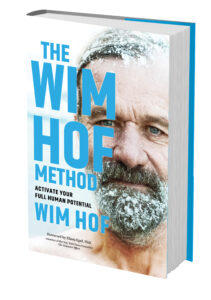 The Book
The Book
Wim Hof shares the life-changing technique that anyone can use to supercharge their capacity for strength, health, and happiness. Join this trailblazing teacher for in-depth instruction on the three pillars of his method (Cold, Breath, and Mindset), the science supporting his techniques, his incredible personal story, and much more.
Show us a day in your life.
Every day is a challenge to do more, as in mindset. My mindset always has been going for the full, everything you got.
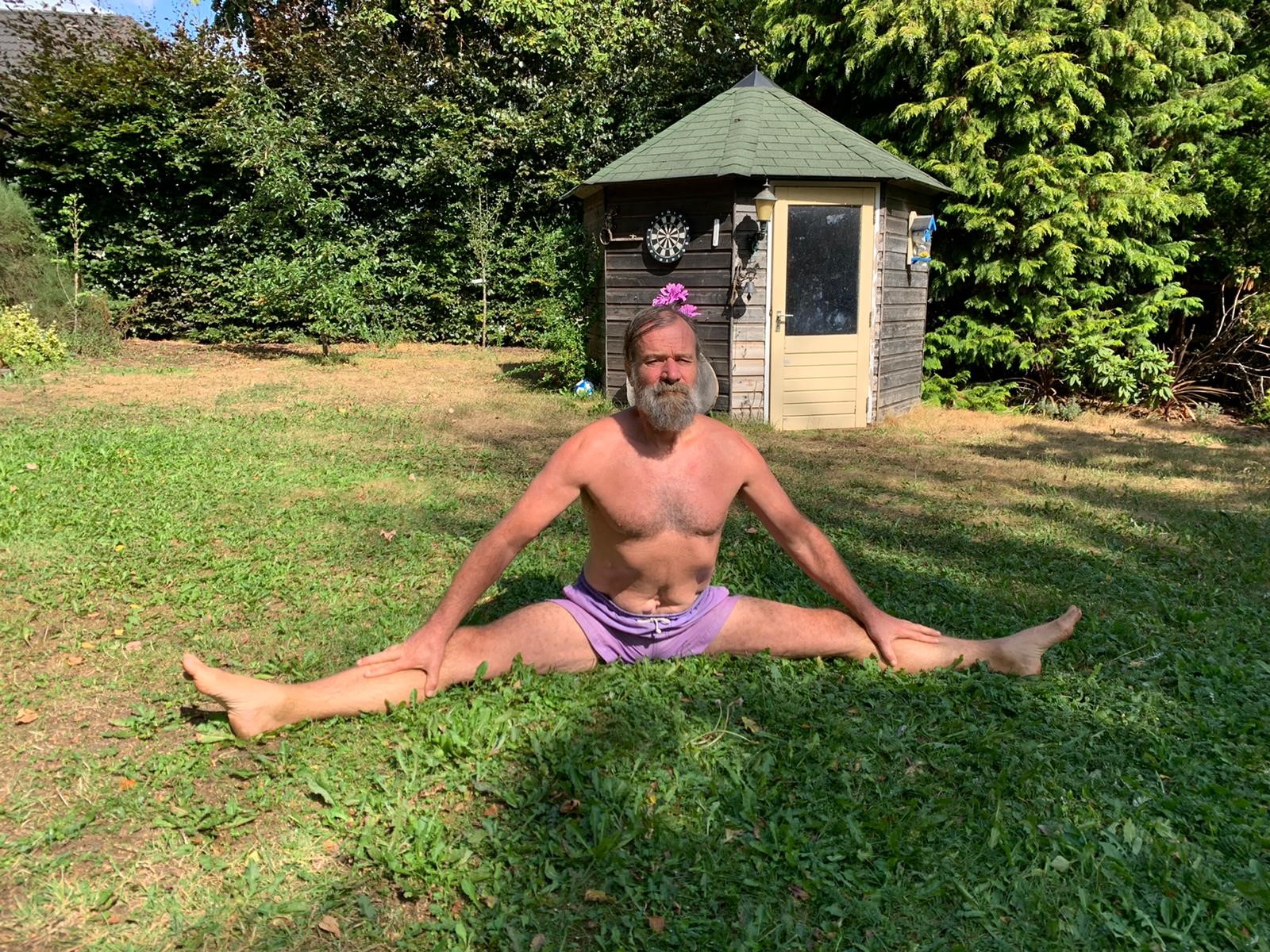
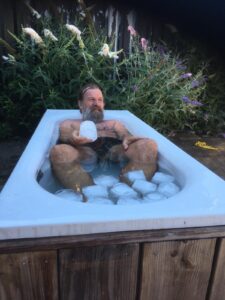 Strong exercising, breathing, postures, power, and ice water.
Strong exercising, breathing, postures, power, and ice water.
I feel everyday gratitude for what has been achieved, which is helping many, many people. My soul knows: you give it all, you get it all.
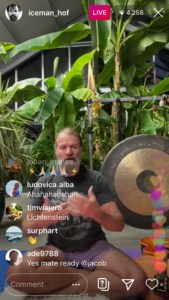
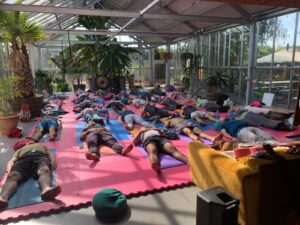
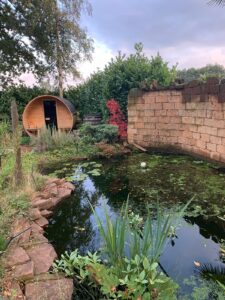
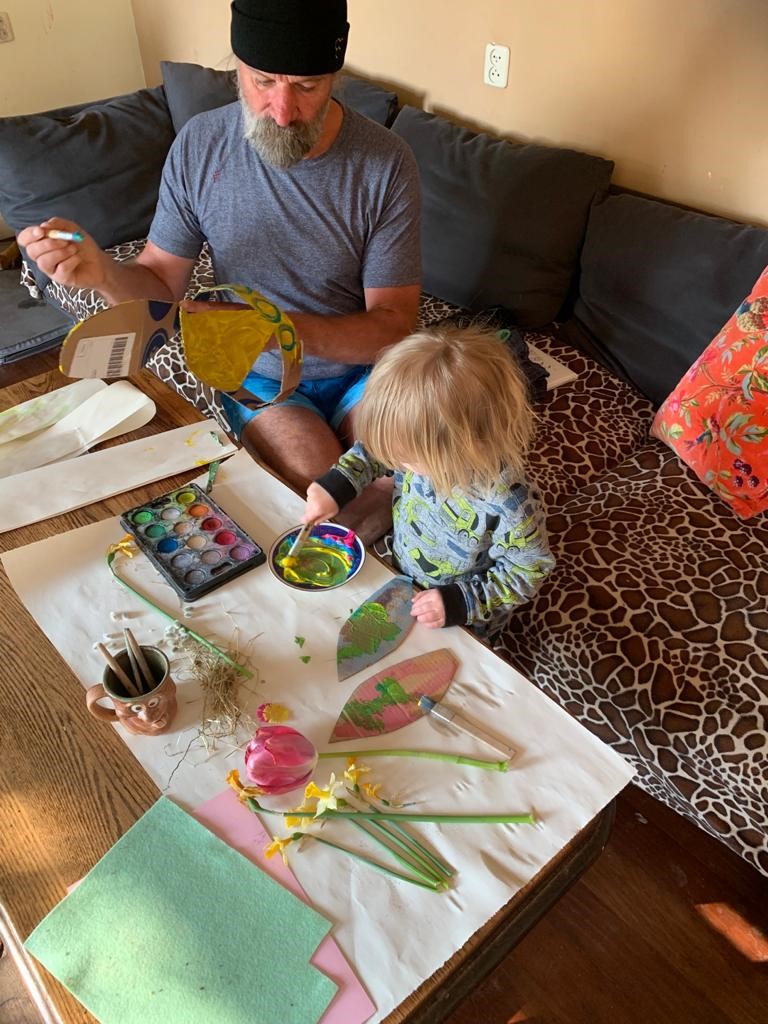
I am very hungry to learn more and go deeper. I spend my days spreading the message as wide as I can. I love my garden, coffee, and my kids—so much richness in my life.
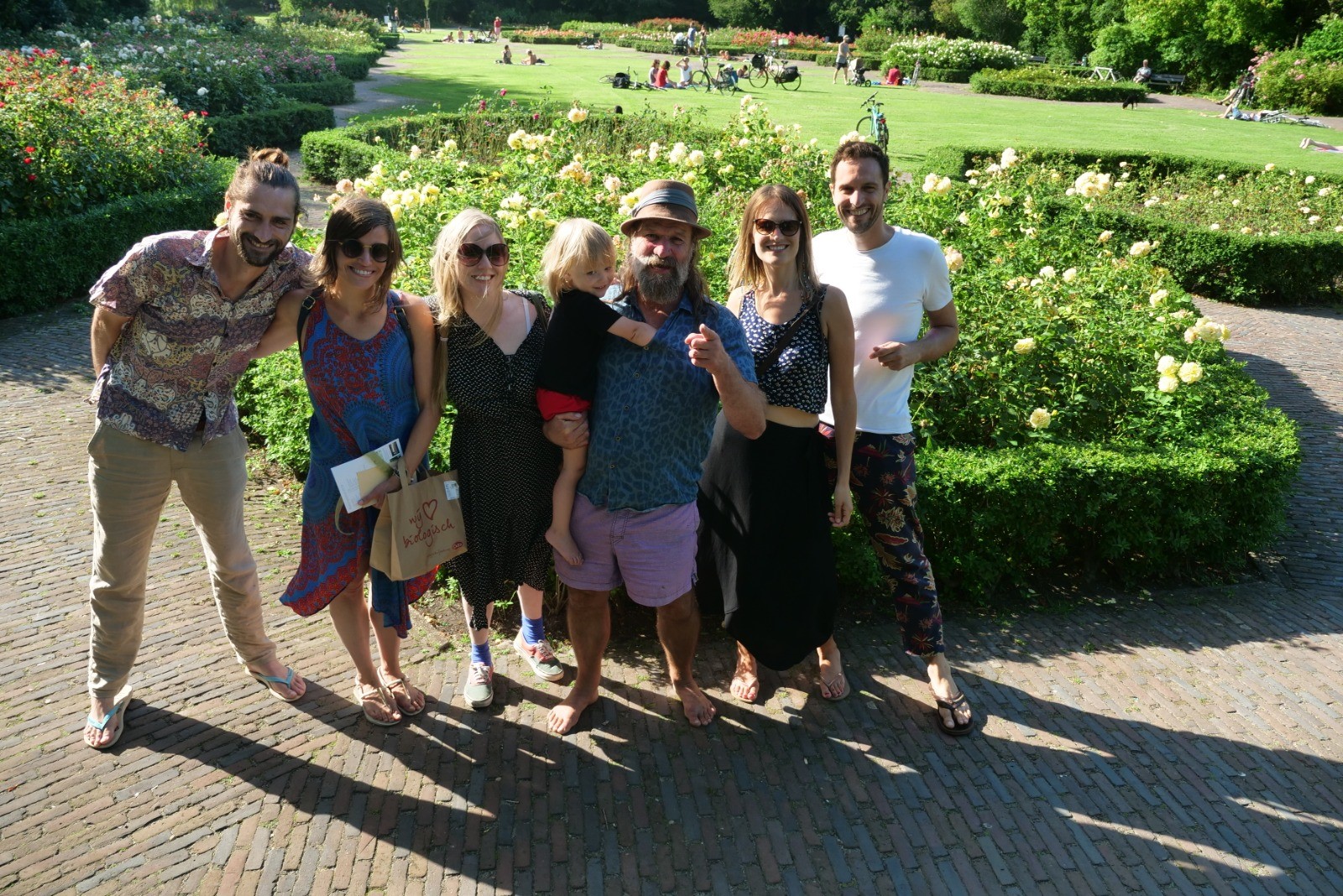
So, I see my everyday routine as a new opportunity to experience full gratitude. I am alive!
Has your book taken on a new meaning in the world’s current circumstances? Is there anything you would have included in your book if you were writing it now?
This book is needed more than ever. We need to not only strengthen our immune systems but to acknowledge that we are capable of dealing with the influx of information by reconnecting with our inner knowing—our core being. Anxiety and stress alike, we are able to create a new foundation for health, happiness, and strength in these challenging times. It’s a great gift to yourself to read this book.
Share a photo of you and your pet. Did your pet have a role in helping you write your book?
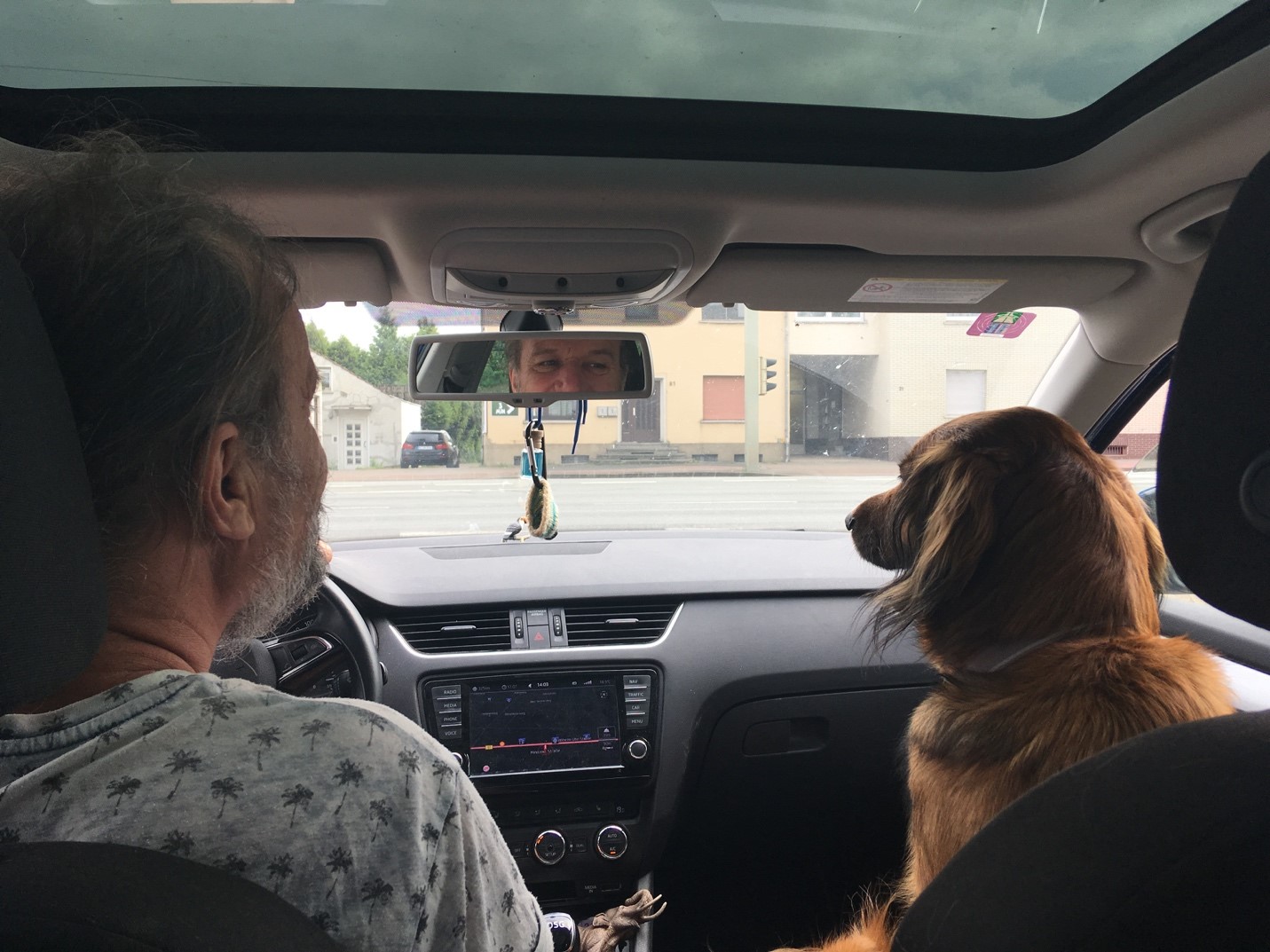
Zina is my guru, she is my brown shadow. She is so unconditionally loyal. She gives me beautiful light—we are true companions.

Learn More
Amazon | Barnes & Noble | Indiebound | Bookshop | Sounds True
The Way of the Feminine to Save the World
You feel special. Sometimes this feels like a curse. Like no one will understand you. Ever. Like you will always be an alien walking among regular humans, pretending to blend in. You have learned to live with this gulf, but what you really crave is community. You long to belong to the human family. To Mother Earth.
Participating in the human condition can be bewildering. It is just not always cozy and easy—rather, it’s humbling at best, downright humiliating when it is not flowing. It can seem so much simpler to ride solo, slaying your own dragons and singing the ballads you wrote about yourself. Collaboration can be tedious, and the prevailing masculine value system may have conditioned you to feel like you are giving away your power when you share it with others.
So what? Give it away. The time of the singular sage bestowing his unique wisdom is over. That was a method devised by the men in charge who sought to regulate wisdom. They taught us to suffer alone in the desert for forty years, collecting our insights in a secret box called “Esoteric Knowledge.” Then, we were supposed to dispense those insights stingily to those who proved themselves worthy by also suffering alone for the requisite forty years in the desert.
It turns out that the world is filled with special beings, grappling our way through the anxiety of solitary conundrums and tasting the occasional reprieve of connection. When you realize this, your body lets out its breath and relaxes. The curse lifts. You come in from the cold. You hold out your cup, and some other special being fills it with sweet, milky tea spiced with fragrant herbs. You drink.
Our way, the way of the feminine, is to find out what everyone is good at and praise them for it and get them to teach it to one another. Maybe you know something about the hidden meaning of the Hebrew letters, or how to build a sustainable home from recycled tires and rammed soil, or loving-kindness meditation. You, the one who knows the Islamic call to prayer, climb this minaret and call us all to prayer. You, the one who knows how to sit quietly at the bedside of the dying, show us the way to bear witness. You, the one who knows how to get us to wake up to the shadow of privilege, please wake us the #*#@ up. It will be chaotic, all this community building, but your cooperation will save the world.
Besides, it will be fun.
What Triggers Your Emotional Inflammation?
It’s time to start unraveling the mystery of you by exploring your current state of mind. Think of this as an adventure, a path toward greater self-understanding and self-compassion—and an expanded appreciation of the complexity of you. To get a sense of the modern-world issues that tend to rile or upset you, put on your imaginary miner’s hat and head into the depths of your mind to see what lies below your conscious awareness. (You may want to do this with a trusted friend or partner.)
Consider your true feelings about the following subjects, without letting preconceived ideas about the right or politically correct way to think or feel about these subjects guide you; simply let your real feelings flow out of you in a free-association style.
Have a journal and a piece of paper ready. As you read the following words and phrases, jot down the first three to five words or phrases that come to your mind in response (don’t edit or change what occurs to you instinctively):
- • Climate crises
- • Me Too scandals
- • Human rights abuses (on a grand scale)
- • Political corruption
- • Racial, religious, gender, or political discrimination
- • Environmental threats (toxins in our midst)
- • Volatile financial circumstances
- • Natural disasters (wildfires, floods, storms)
- • International threats
- • Social divisiveness in this country
- • Hate crimes
- • Nuclear weapons threats
- • Gun violence
If other current events are triggering emotional inflammation for you, write them down in your journal or on a piece of paper.
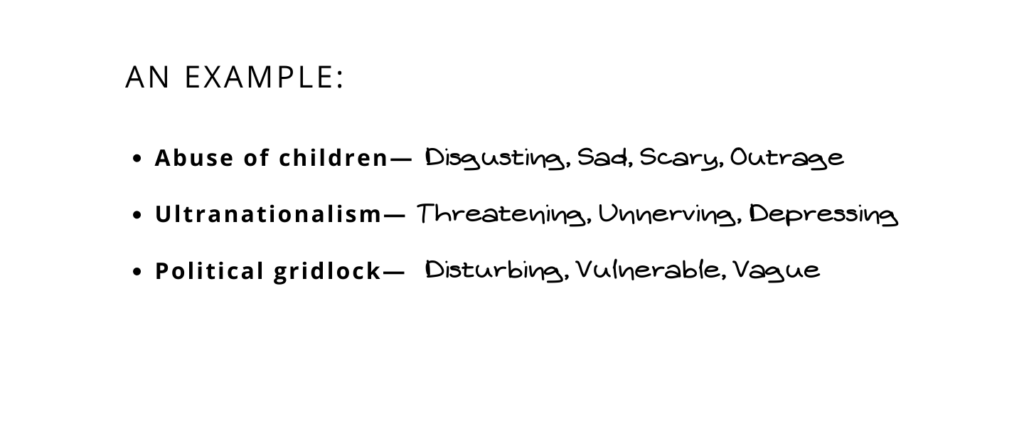
Don’t worry if you feel put on the spot, thought-tied, and unable to come up with the right words to describe how you feel in response to the prompts listed above. Take a deep breath, exhale, and peruse this sample response. Rather than letting this person’s examples sway or influence you, try to use them as inspiration to unlock the floodgates on your true feelings.
Now it’s your turn!
After you’ve completed your list, assign a value to each of these concerns in terms of their potency for you on a scale of 0 to 3 (with 0 being neutral and 3 being intense). Do this quickly so you don’t have too much time to think about it or second-guess your instinctive responses. Once you’ve finished this, place these triggers into a hierarchical list from a potency of 3 to 0, based on how they affect or resonate with you. This will give you a sense of what is likely to get you riled up these days.
If you want to dig a bit deeper, think about the way you responded to the descriptions of certain triggers—that you felt disgusted, violated, sad, and threatened when you thought about Me Too scandals, for example—then consider whether any situations from your past have evoked similar feelings for you. As you may see, emotional injuries or reverberations from the past can make you vulnerable to similar insults and assaults in the present. It’s almost as if you have an emotional ember lying beneath your consciousness, and it’s predisposed to flaring up from time to time. If you hear a single piece of distressing news and find yourself reacting surprisingly strongly to it, think about what else may be crashing around you or whether the news has somehow opened Pandora’s box and exposed you to a deep abyss of other fears and worries. Or it may be that a more superficial emotional injury is on the way to healing but then the scab gets ripped off and the wound bleeds again when another upsetting event occurs.
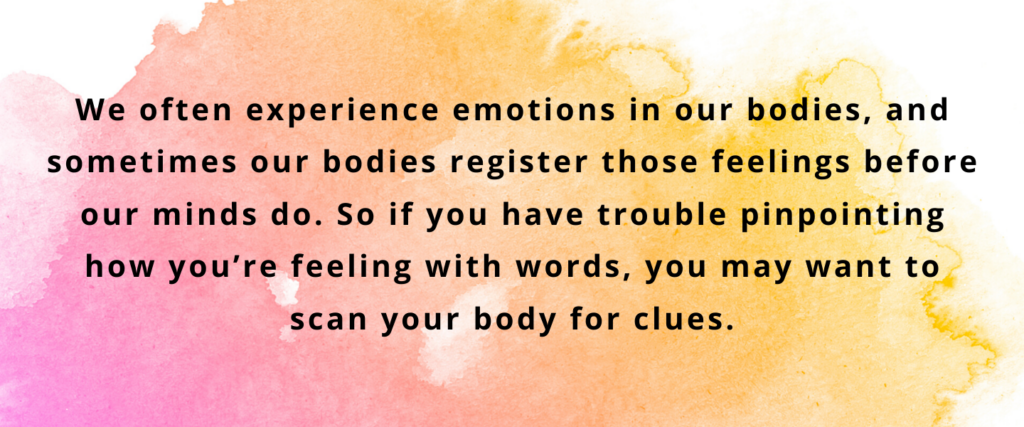
As it happens, we often experience emotions in our bodies, and sometimes our bodies register those feelings before our minds do. So if you have trouble pinpointing how you’re feeling with words, you may want to scan your body for clues. When researchers in Finland performed a series of cross-cultural studies with 701 people from West European and East Asian cultures, they had the participants view various words, stories, movies, or facial expressions, then color specific regions on silhouettes of bodies where they felt activity increasing or decreasing while they viewed each stimulus. This exercise in mapping bodily sensations in response to emotions revealed that basic emotions—including anger, fear, disgust, happiness, sadness, and surprise—were associated with sensations of elevated activity in the upper chest, which likely reflects changes in breathing and heart rate. Increased sensations in the arms and torso were associated with anger. Decreased sensations in the arms and legs corresponded to sadness. And increased sensations in the gut (the digestive system) and throat were found primarily with disgust. The most fascinating revelation was that these effects rang true among people cross-culturally.
So if you have a mental block that makes it difficult to recognize your emotional triggers (which some people do, in a subconscious effort to protect themselves from emotional discomfort), paying attention to your bodily sensations can give you clues about what you’re experiencing. Even if you are highly attuned to your emotional reactions, sometimes they can sneak up on you, and you might experience a particular bodily sensation before you are aware of the actual trigger or your response to it. That’s because we all have blind spots to reflexive emotional states we’re susceptible to experiencing.
This is an excerpt from Emotional Inflammation: Discover Your Triggers and Reclaim Your Equilibrium During Anxious Times by Lise Van Susteren, MD, and Stacey Colino.
Buy your copy of Emotional Inflammation at your favorite bookseller!
Sounds True | Amazon | Barnes & Noble | Bookshop
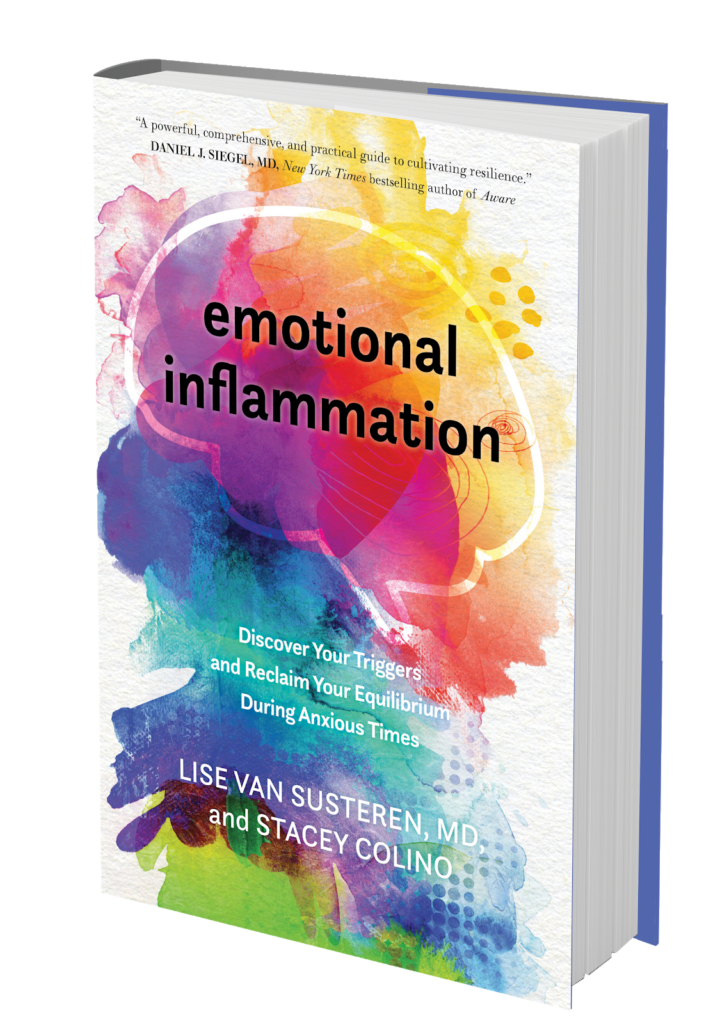
The Basics of Natural Awareness 101: Relaxing Effort

There are three deliberate mental shifts you can make during classical mindfulness meditation that can help point you toward natural awareness: relaxing effort, broadening attention, and dropping objects.
Relaxing Effort
Using effort in classical mindfulness meditation typically means working to bring our attention back to whatever is the present-moment experience. We rigorously and faithfully return our attention to our main focus, typically our breathing. The moment we notice we’ve gotten lost in thought, we deliberately redirect our attention back to our breathing. It can be very hard work. I’ve seen meditators covered in sweat, straining to be aware.
This type of overexertion in meditation is too extreme. In classical mindfulness meditation, we need to be balanced between effort that leads to clear seeing and too much effort that doesn’t really serve us. Some meditators experience a lot of self-judgment, believing that they’re not trying hard enough.
Classical mindfulness meditators typically report that focusing gets easier over time. They can stay aware of their breathing for extended periods, or they find that they return their attention to their breath more quickly when it wanders away. Some people call this ease effortless effort—an experience in our meditation practice where we are making an effort, but it doesn’t seem hard to do at all.
Relaxing effort to shift into natural awareness is a little different. It means that we rein in the tendency to try to put our attention on our breath or other objects, and instead we just be with the objects as they arise.
I think a common concern of many meditators is that if they stop trying, then nothing will happen. Meditators also worry that their mind will wander all over the place if they are not making any effort to do something with it. Well, just sitting down and not doing anything wouldn’t be natural awareness practice; it would be sitting down and doing nothing. So that’s not what we’re trying to do here. Dropping or relaxing effort is very different in that we are tuning in to the awareness that is already present, without trying hard to get there. We also don’t necessarily have a wandering mind because we relax effort on the heels of having worked hard to pay attention.
Think of shifting into natural awareness like riding a bicycle. Often we pedal really hard, but at a certain point, we stop pedaling and begin coasting. The bike stays upright, and we continue to head wherever we’re going, but we’re not working so hard. In fact, it’s usually quite exhilarating to coast on a bicycle. The coasting is dependent upon the earlier pedaling stage, just like effortlessness in meditation is dependent upon the effort you made earlier—particularly the effort to concentrate your mind.
So what does relaxing effort feel like in meditation? It feels like stopping the attempt to wrestle with your unruly mind, to bring it effortfully back to the present, and instead resting, relaxing, and exploring the awareness that is already present. It often feels like things are just happening on their own, and we’re witnessing them. It can feel immensely relaxing and joyful to stop the struggle. We may lose the effortlessness, and then it takes a bit of effort to return to it (such as deliberately returning our attention to our breath for a few moments—or, to return to our bicycle analogy, pedaling for a block or two), but for the most part we are coasting, not pedaling. This relaxing of effort is one way to access a natural awareness.
Try it now:
Relaxing Effort Practice
Start your meditation session by closing your eyes, if you wish, and taking about ten minutes to develop focus and calm by rigorously paying attention to your breathing. When your attention wanders, bring it back to your breathing with regularity and precision.
After ten minutes, see if you can simply pause the effort you are making. Relax a bit (and that may include relaxing your body), and notice what is happening without you trying to be aware. Is awareness present? Are you naturally aware of what is happening in your body or mind, without deliberately placing your attention on the object? Can you sense the way awareness is happening, kind of on its own, and how you are present without having to work at it?
If you notice yourself getting lost in thoughts, then make an effort to come back to your breath for a while. But then stop making an effort again and see what happens.
Continue reading the next steps, Broadening Attention and Dropping Objects.
This is excerpted from The Little Book of Being: Practices and Guidance for Uncovering Your Natural Awareness by Diana Winston.

Diana Winston is the director of Mindfulness Education at UCLA Semel Institute’s Mindful Awareness Research Center (MARC) and the coauthor, with Dr. Susan
Smalley, of Fully Present: The Science, Art, and Practice of Mindfulness. She is a well‑known teacher and speaker who brings mindful awareness practices to the general public to promote health and well‑being. Called by the LA Times “one of the nation’s best‑known teachers of mindfulness,” she has taught mindfulness since 1993 in a variety of settings, including hospitals, universities, corporations, nonprofits, schools in the US and Asia, and online. She developed the evidence‑based Mindful Awareness Practices (MAPS) curriculum and the Training in Mindfulness Facilitation, which trains mindfulness teachers worldwide.
Her work has been mentioned or she has been quoted in the New York Times; O, The Oprah Magazine; Newsweek; the Los Angeles Times; Allure; Women’s Health; and in a variety of magazines, books, and journals. She is also the author of Wide Awake: A Buddhist Guide for Teens, the audio program Mindful Meditations, and has published numerous articles on mindfulness. Diana is a member of the Teacher’s Council at Spirit Rock Meditation Center in Northern California. She has been practicing mindfulness meditation since 1989, including a year as a Buddhist nun in Burma. Currently, Diana’s most challenging and rewarding practice involves trying to mindfully parent an eight‑year‑old. She lives in Los Angeles.
For more information, visit dianawinston.com and marc.ucla.edu.
Buy your copy of The Little Book of Being at your favorite bookseller!
Sounds True | Amazon | Barnes & Noble | Indiebound


